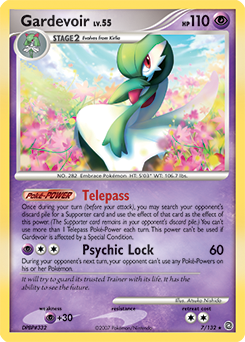The Sinnoh era of the Pokémon TCG is near and dear to many of the amazing people we’ve
invited to discuss their favorite cards. Not only was this an era of
adventurous card designs with Team Galactic Trainer cards and Pokémon SP,
these cards contributed to some of the most epic Championship matches in the
game’s history.
Read
what our group has to say about their absolute favorite cards from this era,
and be sure to check out previous entries from the Sword & Shield, Sun & Moon, XY,
and Black & White eras. Then, check back next month as our 25th
celebration sets its sights on Hoenn.
Tord Reklev
Three-Time International Champion
Uxie from
the Diamond & Pearl—Legends Awakened expansion introduced an
incredible draw power to the game. Its iconic and fittingly named Set Up Poké-Power
allowed the player to instantly draw cards until they had seven cards in their
hand. The consistency-focused Pokémon we are used to from newer eras of the
game, such as Dedenne-GX
or Crobat V, have the big liability of giving up two Prize cards; Uxie’s
only drawback was occupying a Bench spot. Unlike Crobat V, Set Up was also not
limited to once per turn, which allowed decks to use multiple instances of Set
Up to have explosive turns when needed. At the time, the most powerful Supporter
cards had effects that allowed the player to search out Pokémon. Uxie could
turn a search-based Supporter like Roseanne’s Research into a powerful
draw effect, making it a staple in almost all competitive decks at the time.
Uxie’s Psychic Restore attack could be used to put Uxie and all its attached
cards on the bottom of the player’s deck, freeing up Bench space and allowing
the player to reuse Uxie’s Poké-Power later in the game. In a pinch, this
attack could also be used to prevent the player from decking out.
Also from Diamond & Pearl—Legends Awakened, Azelf has
one of the most fun and powerful Poké-Powers imaginable. In a Pokémon TCG game,
one of the few things that’s normally out of your control is the content of
your Prize cards. After enough games, one or more of your important Pokémon
will be Prized. Azelf’s Time Walk Poké-Power allowed the player to fish out any
Pokémon from their Prize cards and get access to it immediately. This gave
players who used to deck search to deduce what cards were Prized a big
advantage when deciding to use Azelf or not. Another big detail to note is that
Time Walk did not require the player to shuffle the Prize cards afterwards.
This meant that for the rest of the game, the player would know the location of
every Prize card and be allowed to take them in the order they would deem the
most optimal. Azelf essentially removed one of the biggest variance factors in
the game.
The Lock Up attack was also more useful than it would seem at first glance. It
could trap a plethora of weak Pokémon in the Active Spot to buy crucial time
for setting up your own field.
Jason Klaczynski
Three-Time Pokémon TCG World Champion
During the Power Spray era, players facing three or more
Pokémon SP (Pokémon representing powerful Trainers from the Sinnoh region)
would announce their Poké-Power, then anxiously wait for their opponent to give
them the go-ahead. The Pokémon SP player might not even have a Power
Spray in hand to stop you—it was up in the air!
Even the threat of
a Power Spray forced players to rethink their plans. Let’s say you played Roseanne’s Research, hoping to retrieve two Basic
Pokémon. You might want to grab a Uxie to
use its Set Up Poké-Power, and a different Basic Pokémon to evolve later. But
what if your opponent had Power Spray to deny you Uxie’s Set Up? Without this
pivotal Poké-Power, your game plan might immediately be upended. Perhaps you
should forgo that other Basic Pokémon and instead go for two Uxie, then? This
would make the opponent need two copies of Power Spray to stop
you.
These kinds of decisions
and interaction made for fun gameplay. And the fact that the card was easily
retrievable by Cyrus’s Conspiracy
made it reliable and strong, as players anticipating an upcoming
Poké-Power could grab Power Spray to be prepared.
This unique strategy to
interrupt the opponent’s turn was short-lived. After Power Spray rotated out of
the Standard format in 2011, the game never again saw this kind of surprise interrupt
card.
Gardevoir
was the focus of my 2008 World Championship-winning
deck and a deck that dominated throughout that season. Gardevoir’s competitive
success stemmed from the fact that it had so many different
things going for it.
To start with, it was
easily paired with Gallade.
This provided Gardevoir players access to two powerful Stage 2 Pokémon while
also saving deck space. Gallade was better on offense, using its Psychic Cut
attack to deliver one-hit KOs. While Gallade attacked, Gardevoir could sit
safely on the Bench, providing support with its Telepass Poké-Power.
These extra Supporters
from Gardevoir’s Telepass allowed you to achieve impressive setups of multiple
Stage 2 Pokémon that would overwhelm your opponent. Pulling out thin Evolution lines
(like a 1-0-1 Dusknoir line)
via Rare Candy became easy.
When it came time to
attack with Gardevoir, its Psychic Lock attack was sure to be disruptive, as decks
relied heavily on Claydol‘s Cosmic
Power. And though Psychic Lock required three Energy, Double Rainbow Energy and Scramble Energy allowed you to easily fuel
multiple Gardevoir, ensuring you could keep the Psychic Locks coming. There
were only so many of these attacks an opponent could handle before their board
crumbled, leaving Gardevoir as the last Pokémon standing when the sixth Prize
card was taken.
Michael Pramawat
Europe International Champion, Worlds Runner-Up
Team Galactic’s Wager is
one of the most iconic cards in Pokémon TCG history. This card is unique in
that it requires the players to play Rock-Paper-Scissors. Team Galactic’s Wager
forces both players to shuffle their hand into their deck, then the winner of
this showdown gets to draw six cards—while the loser draws only three. Forcing
players to play a minigame over the fate of the larger Pokémon TCG match is
something that is rarely seen even in the current version of the game.
This
card dominated the tournament scene when it was Standard-legal. Pretty much every
deck played this card, which caused some funny instances. The most famous
instance of this card being played was when three-time World Champion Jason
Klaczynski had an extremely long chain of Rock-Paper-Scissors in the top cut of
the World Championships. This card, in combination with Gardevoir‘s Telepass
Poké-Power, made for an extremely disruptive combo that is seen as one of the
best decks ever made in the game.
Claydol is
possibly the best support Pokémon ever printed. The stats on this card are
relatively unimpressive, but that is all secondary to its Cosmic Power Poké-Power.
Claydol allowed the player to cycle bad cards from their hand and draw new ones
every turn. In addition to this, if a player got out multiple Claydol, then
they could use multiple instances of Cosmic Power each turn. This allowed players
to go through their entire deck very quickly—and, as a side effect, to avoid
decking out, because they were returning cards from their hand to the deck. The
deck that made the best use of Claydol was undoubtedly Jumpluff. Jumpluff is very
similar to current decks in the fact that it tries to draw and play as many
cards as possible.
It
isn’t too far off to say that the format during this time revolved around
Claydol. Figuring out how to hinder your opponent’s Claydol was part of
everyone’s strategy: Garchomp C Lv.X
targeting Benched Claydol for a one-hit Knock Out was extremely common; Gardevoir used
Psychic Lock to stop Cosmic Power; and even Power Spray was often used on Claydol.
Claydol
was worth including in virtually every deck, making everything around it that
much better.
Ross Cawthon
17 World Championships Appearances, Two-Time Worlds Runner-Up
The Pokémon SP cards of the Platinum era made for
some very powerful decks. Pokémon SP included many good Basic Pokémon
and Pokémon Lv.X; and it worked with the dominant Team Galactic
Inventions: Energy Gain, Power Spray, and Poké Turn. Some of the best Pokémon SP
included Luxray GL Lv.X, Garchomp C Lv.X, and Dialga G Lv.X.
For my favorite Pokémon SP, though, I chose Palkia G Lv.X. Its Lost Cyclone Poké-Power
created some really fun combinations, particularly with the trio of Mesprit, Uxie, and Azelf from Diamond & Pearl—Legends Awakened. Each of these
Pokémon had great Poké-Powers that can only be used when they are put into
play. The downside of such cards is they are pretty useless after that, hogging
Bench space for little impact. Lost Cyclone fixes this, sending those Pokémon
to the Lost Zone (a new concept introduced with the Platinum Series) and
giving you room to use more powerful Poké-Powers next turn. Using Mesprit’s
Psychic Bind multiple turns in a row was particularly devastating. Of course,
you can also use Power Spray with enough Pokémon SP. This combination of
cards could shut out Poké-Powers for practically the entire game! Against
certain decks, limiting an opponent’s Bench with Lost Cyclone was also
important.
This was a truly spooky card. If you had four or more Benched
Pokémon, an opposing Dusknoir‘s Dark Palm Poké-Power could send your best Pokémon on the Bench
into your deck, along with all its attached cards. Your Active Pokémon wasn’t
safe either, as Warp Point
could send it to the Bench. The worst part was that if you immediately played a
Pokémon back down, you’d be in Dark Palm range again. You would often have to
wait until multiple copies of your Pokémon were Knocked Out until you were safe
from Dark Palm, but by then you were probably too far behind to win.
Modern players may say, well, it’s a Stage 2 Pokémon, it can’t be that
scary. Once you see Duskull, just Knock it Out or play around
it. Well, young whippersnappers, back in these days, you could play Rare Candy on a Pokémon the same turn you
played it down! That’s right—Dark Palm was always theoretically an option on
the next turn, even with no Duskull in play. Many decks would play one Duskull,
one Dusknoir, and one or more Rare Candy just because it could swing a game so
easily. You were never sure that your opponent wouldn’t play Dusknoir and
couldn’t Dark Palm you next turn if you Benched that fourth Pokémon. And it was
very rare to win a game in which you were Dark Palmed.
Mike Martin
20-year Pokémon TCG Professor
Broken Time-Space was, well,
broken. It allowed you to break the rule that Pokémon can’t evolve on either
player’s first turn. It allowed you to break the rule that you can’t evolve a
Pokémon on the same turn that you played it. And, finally, it allowed you to
break the rule that you can’t evolve from Basic to Stage 1 to Stage 2 all in
the same turn! In short, it made Stage 2 Pokémon a force to be reckoned with.
Usually,
Stage 2 Pokémon suffered from a time drain. It normally took multiple turns to
get one into play. And even if you were using Rare Candy, you were still
limited to only a few Evolutions that way. By the time you got your Stage 2s
out and powered up, your opponent who was playing “Big Basics” had already set
up and taken half of their Prize cards.
But
with Broken Time-Space, you could get out multiple Stage 2 attackers and Stage 2
support Pokémon relatively easily. A bit too easily, one might say. Take Machamp, for example.
For one Energy, Machamp could Knock Out any Basic Pokémon, no matter how
many HP it had. With Broken Time-Space, you could evolve Machop all the way up
to Machamp early in the game and take out your opponent’s only Basic Pokémon. I
doubt we’ll see another card with an effect quite that powerful again.
The
Platinum Series introduced a range of Pokémon SP, usually Basic Pokémon
that would normally be Stage 1 or Stage 2. One of the most widely used Pokémon
from this series was Crobat G.
While its attack wasn’t very strong, it had two attributes that put it in
almost every deck. First, it had no Retreat Cost, which in itself could be very
useful as a way to bring up a Pokémon to the Active Spot and keep your options
open for retreating into something else without having to spend a Trainer card
or discard Energy to do so.
But
where it really shone was with its Poké-Power. Flash Bite allowed you to put
one damage counter on one of your opponent’s Pokémon when you played Crobat G
to the Bench. We have a similar card being used in the Standard format now in Galarian Zigzagoon. But Crobat G
has the OG version of this effect. It was easily retrievable via deck search, and
as a Basic Pokémon, you didn’t need to invest in a lot of Evolution cards just
to get it into play. Since you could put the damage counter anywhere, it could
act as a searchable PlusPower or
snipe a damaged Benched Pokémon that was out of reach. And with the Poké Turn Trainer card, which
allowed you to return a Pokémon SP from play back into your hand, you
could place that critical damage counter again and again. I saw many games at
World Championships end in victory for players who knew how to use their Crobat
G well.
The Pokémon TCG community would not be the same without these five contributors to the game, and we appreciate their valuable insights. Be sure to check back throughout the year to see more of their reflections on their favorite cards from the long history of the Pokémon TCG.
About the Contributors

Tord Reklev
Tord Reklev is a contributing writer for Pokemon.com. He is a longtime player from Norway, playing the game since he was 6 years old. He is notable for being the only Masters Division player to win the North America, Europe, and Oceania Internationals, and he recently made Top 4 at the World Championships. Outside of the game, he is a student and enjoys playing tennis. You can find him at most big events, and can follow him on Twitter at @TordReklev.

Jason Klaczynski
Jason Klaczynski is a three-time Masters Division World Champion (2006, 2008, 2013) and the 2015 US National Champion. Jason began playing the Pokémon TCG during the initial Pokémon craze of 1999 and played competitively from that point through 2017. Since then, Jason has focused on re-exploring and writing about the game’s earliest formats, which he regularly plays with friends.

Michael Pramawat
Michael Pramawat is a seven-time Regional Champion and International Champion. He has competed at the highest level and was almost World Champion, finishing second in 2010. Michael is a master of the Pokémon TCG and continues to play with the goal of being the very best, like no one ever was. You can follow him on twitter at @michaelpramawat.

Ross Cawthon
Ross Cawthon is a longtime player, starting to play tournaments in 2000. He is the only player to compete in all 17 Pokémon TCG World Championships, finishing as a finalist in 2005 and 2011, and a semi-finalist in 2016. He is known for creating many new “rogue” decks over the years. Ross has a Ph.D. in astrophysics and studies dark energy (not to be confused with Darkness Energy cards).

Michael Martin
Michael Martin, AKA “PokePop,” hasn’t won a single tournament. He has been judging and running Pokémon TCG events since 2000 and has been invited to judge at every single Pokémon World Championships. He also helps maintain the Pokémon TCG Compendium, where all official game rulings for Organized Play are collected. ‘Pop misses seeing all the players and other Professors in person and can’t wait for live events to resume.
 Source: Pokemon
Source: Pokemon











